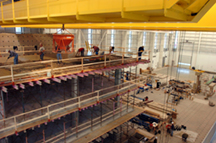
September 20, 2005
Purdue civil engineers test earthquake resistance of Army buildings

|
WEST LAFAYETTE, Ind. – Civil engineers at Purdue University are using a specialized laboratory to test a 32-foot-tall structure resembling a portion of one type of U.S. Army barracks built on the West Coast to determine the susceptibility of aging military buildings to earthquake damage.
"This project came about because the military has some barracks built in the late 1950s and early 1960s, before the development of current building codes, and there is interest in understanding the integrity of those structures," said Michael Kreger, a professor of civil engineering and director of Purdue's Robert L. and Terry L. Bowen Laboratory for Large-Scale Civil Engineering Research.
Features in the laboratory, completed in 2004, include a testing area with a "strong floor" and 40-foot-high "reaction wall" containing numerous holes in which to anchor powerful hydraulic actuators that apply forces to large-scale structural models.
The engineers constructed a 32-foot-tall building model in the lab resembling a portion of the interior of Army barracks built in states on the West Coast. The hydraulic equipment will be used to simulate the "lateral loads" induced by the ground motion of earthquakes.
Earthquakes cause portions of a structure to momentarily deform. The engineers are using various instruments attached to the structure to determine precisely how much deformation takes place in different parts of the building when subjected to the forces.
"One advantage of having a lab like this is that, instead of testing small models, we can test full-scale structures, which yields the most accurate data possible," said Mete Sozen, the Kettelhut Distinguished Professor of Civil Engineering. "There are only a handful of university labs in the country that could enable you to perform this kind of full-scale testing."
Officials are concerned that a powerful enough earthquake could cause supporting columns in the barracks to separate from the reinforced-concrete floor slabs, resulting in collapse.
"If we determine that this structure could potentially collapse when it experiences extreme deformations, the Army could then go back and rehabilitate these structures to make the barracks more resistant to earthquakes," Kreger said. "We know much more about earthquake-resistant design today than we did 50 years ago when these buildings were constructed."
The engineers eventually will publish findings from the research.
Writer: Emil Venere, (765) 494-4709, venere@purdue.edu
Sources: Mete Sozen, (765) 494-2187, sozen@purdue.edu
Michael Kreger, (765) 494-9340, kreger@ecn.purdue.edu
Purdue News Service: (765) 494-2096; purduenews@purdue.edu
PHOTO CAPTION:
Workers complete construction on a large-scale model of a U.S. Army barracks inside Purdue University's Robert L. and Terry L. Bowen Laboratory for Large-Scale Civil Engineering Research. Civil engineers are using the specialized laboratory to test the 32-foot-tall structure to determine whether the aging military buildings are dangerously susceptible to earthquakes. Features in the laboratory include a testing area with a "strong floor" and 40-foot-high "reaction wall" containing numerous holes in which to anchor powerful hydraulic actuators that apply forces to large-scale structural models. (Purdue News Service photo/David Umberger)
A publication-quality photo is available at https://www.purdue.edu/uns/images/+2005/kreger-army.jpg
To the News Service home page